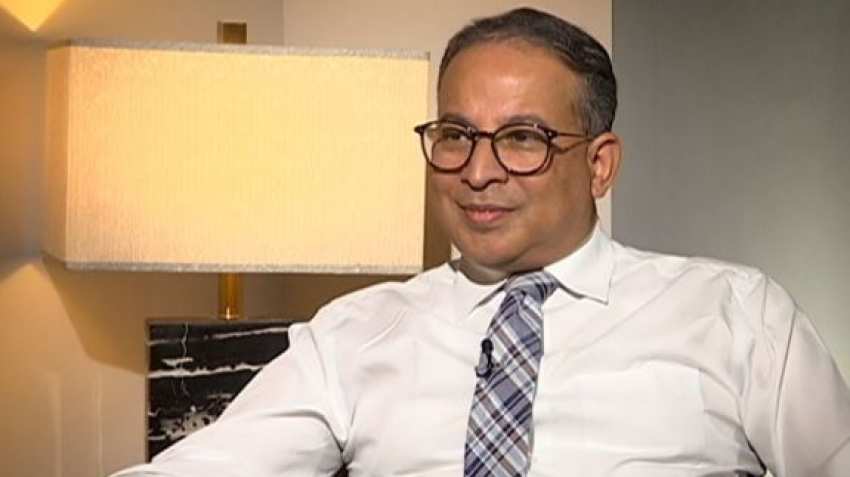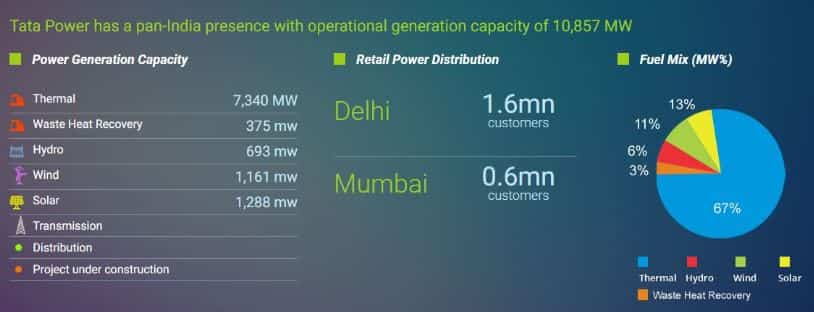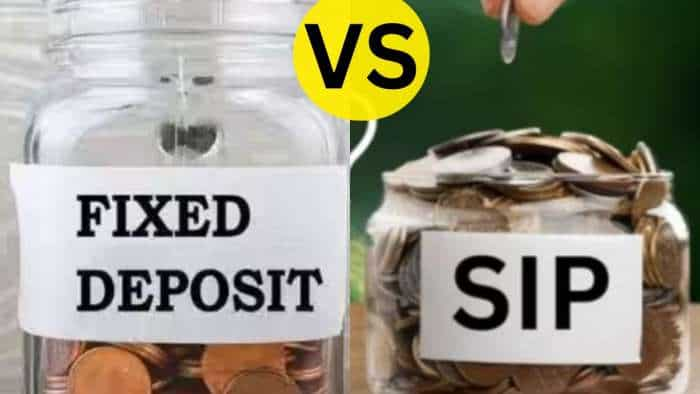Tata Power is becoming a consumer-centric company rather than just being a power producer: Praveer Sinha, CEO & MD
Our losses from Mundra stood at Rs1,700 crores last year and it will be brought down by Rs 500 crore this year, says Praveer Sinha, CEO & Managing Director, Tata Power Co. Ltd. During an interview with Swati Khandelwal, Zee Business, Mr Sinha said, “disinvestment of the Cennergi Plant, South Africa, which is in the signing stage, will garner more than $100 million to Tata Power”. Edited Excerpts:

Our losses from Mundra stood at Rs 1,700 crores last year and it will be brought down by Rs 500 crore this year, says Praveer Sinha, CEO & Managing Director, Tata Power Co. Ltd. During an interview with Swati Khandelwal, Zee Business, Mr Sinha said, “disinvestment of Cennergi in South Africa, which is in the signing stage, will garner more than $100 million to Tata Power”. Edited Excerpts:
Q: The problems of the power sector persist, and the sector is struggling despite the government announcing schemes to support it. What are your plans to address the problem and how difficult has been this period for you?
A: Correctly said that the power sector is facing certain problems and it is not 2-3 years old issue, but it has been present in the sector for a long time. There have been some improvements - in terms of generation capacity, which has improved tremendously in the last 20 years. In the process, a lot of capacity has been added and today the country has a power generation capacity of around 360 gigawatts, including nearly 80 gigawatts of renewables. So, a lot of capacity has been added to date But the biggest pain point in the power sector is related to DISCOMs that are going through losses.
Earlier, the government came up with UDAY (Ujwal DISCOM Assurance) Scheme – four years ago – when DISCOMS were going through a loss of around Rs4.3 lakh crores. Thus, DISCOMS of all 29 states and 7 Union Territories (UTs) were going through great losses, which was transferred to the state governments under schemes Integrated Power Development Scheme (IPDS) and Deen Dayal Upadhyaya Gram Jyoti Yojana (DDUGJY) to bring improvement and provide more access of energy to people.
Similarly, SAUBHAGYA scheme was also launched. However, improvements on part of the DISCOMS - like improvement in loss reduction, technology and capacity building among others – haven't happened as it was envisaged. In 2018, we saw a reduction in losses, but it has increased on both fronts – technical losses and financial losses – in 2019. So, there is a need for a large-scale change/transformation in power consumption and distribution. Improvements can’t be seen until and unless these changes are not brought in place in a true sense.
Q: Should something happen from the policy point of view?
A: Yes, it should happen. And, to put a distribution reform in place in true sense, the states will have to come together on a common platform – as distribution of electricity is a concurrent subject – and decide either on the public-private partnership (PPP) or a franchise model or bring multiple-supply companies, as content and carriage is being talked about. Thus, it requires major changes and transformation, and, in its absence, the ongoing improvements will be very small or act as a knee-jerk reaction but will fail in bringing an overall improvement to the sector, as it is expected across the country.
Q: Even, RK Singh has also talked about it, in recent past, and has said that they are doing something around the same lines, but we’ll have to wait for a concrete policy in respect to the same.
A: Yes. The Union Power Minister has two-three positive statements in the last one month like every state - under the new law - will have to open an LC (Letter of Credit) for generation company may it be a conventional generation or a renewable generation. Because, to ensure growth in generation and to bring renewable generation, the generating companies should be provided money on time as they take loans
and bring investors from outside. Thus, they should get their money on time. The second change announced by him is the franchise model in distribution and this is going to be a major improvement, if implemented, and is carried on by every state diligently. It will be a brilliant improvement if the states rope-in experts who have experience and knowledge of the domain and are aware of the technology and the process of integrating it. This would also help the power sector in coming out of the ongoing problems.
Q: Tata Power is a century-old player in the segment and has seen much ups and downs and policy changes. Will the changed regulation of Indonesia will have any overhang impact on Tata Power?
A: Rightly said that Tata Power has been into the business for more than 100 years and if you have a look on power value chain then it is present in almost every section of the sector starting from Hydro-generation to thermal generation (both coal and gas) as well as renewable (Tata Power has taken several initiatives in solar as well as wind), trading, coal mines and shipping among others.
Also, we have thought that to have a focus on the power sector, we will have to concentrate on few areas and that’s why we have decided to concentrate on renewable energy because the present world has an emphasis on renewable generation and distributed generation.
Interestingly, we have developed a platform for thermal and that, Resurgent Power, will help us in the acquisition of certain stressed assets. But the new generation capacity will be installed in renewable and typically, it will be through solar plants and wind plants that we will put.
Besides, we expect that a lot of changes will be introduced in distribution, especially in terms of transformation in state distribution companies in the form of franchise model or multiple supply companies.
And, we have a lot of technology interventions on that front as we have complete idea and experience of integrating a distribution management system with the ERP, among others. So, this is also the second focus area and we are concentrating on these two areas.
In addition to this, we are also concentrating on certain new areas like EV charging but the EV vehicles don’t have much penetration till date, but we expect that creation of its infrastructure in different cities - in the form of home charging or public charging - will provide a good business opportunity for us.
Q: What are your installed capacity in renewables and the target where you want to be in future? Similarly, what are your plans on EV charges, if you want to grow big in the domain, then provide a number for it?
A: When it comes to renewables then we have about 1,100 MW wind energy and 1,500 MW solar energy and about 600 MW of solar is under construction at present. So, we will be able to cross the mark of 3,000 MW by next year. Besides, we are also bidding and have already won 450 MW through bidding and will also bid on the new opportunities that will prop up in states. We have a plan to enhance it annually. So, the current capacity level will be increased by 3-4 times in the next 4-5 years. This is our vision and that is the plan and are working on it.
Q: If, I am not wrong then, 1,000 megawatt of coal thermal needs an investment of about Rs4,000. Then, let us know about the kind of investment that will be needed on renewables?
A: The investment amount is almost the same. In case of solar, a 1,000 MW project needs an investment of around Rs 4,000 crores. Thus an investment of about Rs4,000-4,500 crore is needed for installation of a 1,000MW solar power plant. So, approximately the cost remains same. The only difference is that there is no variable cost in case of solar as the sun is free of cost and that’s why you don’t need any additional investment in it as compared to coal, gas or any other medium. So, the installation of the solar plant needs just a capital cost while its maintenance cost is very low.
Watch Zee Business Live TV below
Q: What is the CapEx that has been planned for capacity addition in renewables and EV charging stations?
A: Most of the CapEx will come through internal accruals because the advanced depreciation that we get from our installed plants and those which are in pipelines provide good EBITDA to us, which can be reused for new projects. In this business, our EBITDA in the results of last year’s and first quarter, especially of the renewable business, grew by 20-25% and we expect that we will be able to post similar 20-25% growth in EBITDA in future as well. So, if we go for 1,000 MW/year then our CapEx will stand around Rs5,000 crores/year and that CapEx will come through internal accruals with profitability of our existing operations.
Q: Update us on Mundra?
A: Five states are involved in Mundra UMPP and Gujarat has approved it. It is supposed to go for approval to Maharashtra Cabinet but unfortunately, it might get delayed due to upcoming elections. Punjab, which too was slow, has shown its interest and the proposal will move to the Cabinet soon. Hopefully it will get approved by the Cabinet within September month. Then, Rajasthan and Haryana are two remaining states and I think that we will have to wait in the case of Haryana till November because elections are scheduled to happen in the state. But in the case of Rajasthan, we feel that it might happen by September or October. So, I think we are in good shape as far as Mundra is concerned because in-principle everyone is ready. If you have a look then around 50% of the capacity of Mundra is with Gujarat, 20% is with Maharashtra, where the Cabinet nod is ready. Thus, the majority is ready, and others are saying that we are ready, but they will have to follow the governmental procedures, which is getting delayed. I don’t think that there is any difficulty. It is a matter of time but it will happen.
Q: How it will impact your finance after getting clearance from different fronts?
A: We had a loss of around Rs1,700 crore last year because coal prices were quite high. This year, we are seeing a trend where the coal prices are going down and we are blending more. Thus, it will stand around Rs1,200-1,300 crore this year and will reduce it by around 50%. We will get savings of around Rs500-600 crore, which is a loss at present and that will come directly into the profitability of the company.
Q: Tell a timeline by when it will reach the breakeven levels and start making profits?
A: It is not very possible in immediate future, but we expect that the ongoing improvements in the plants and the way we have seen that our under-recovery, which stood at around 95 paise, has gone to 55paise in the first quarter. There has been a huge improvement. So, we are making many changes and improvements at the plant. This will help us to increase fuel efficiency. Maybe it will not reach to zero levels, but we will be in a very-very manageable scale.
Q: You have the continuous endeavour of disposing of the non-core assets to reduce the debt on your balance sheet, which stands around Rs48,000 crore gross net. How it has improved from the last time when we spoke?
A: We have divested in Tata Communication and Penaton. We are also hiving off our SED (defence business) to Tata Advanced Systems. And, we have also started disinvestment in our international businesses including the Cennergi unit that we have in South Africa and the hydro-power plant in Zambia. The South African project is almost in the signing process and we will close it within this month.
Q: Tell us the amount that you will garner from that disinvestment?
A: Still it is getting finalised, but it will be little more than $100 million. Similarly, we are finalising the Zambian project and hopefully, it will be closed by the end of this financial year. Besides, we also have certain international operations, which include some smaller coal and shipping investments and we are looking at disinvesting our international operations, where do not have any major growth plans and are not scalable to the extent that we are expecting. This money will be invested in India growth plan especially in the renewable growth plan that needs CapEx. Distribution can generate cash from day one and that’s why it doesn’t need any major CapEx. But we must focus on India investment, especially for renewable for the big solar plans that we have.
Q: Tell us about the expected total amount from non-core assets and the amount that can be recovered in this financial year?
A: We will be able to reduce debt around Rs3,000-4000 in this financial year. We will also try to go for other disinvestments like unused lands, as once we took a parcel of land for our Dherand project plant with plans to develop an imported coal-based plant. We want to disinvest such non-core assets where we do not have any immediate plan for development and will try to consolidate the amount collected from disinvestment of these assets and invest it in growth plans of India.
Q: Don’t you think that this is a wrong time for disinvestment as values are subdued?
A: No, it is not so. Whenever you are out in the market to sell something then you will have to be competitive. I think everyone has different business plans. This is not the first time that we are going for it. At the time we announced our disinvestment plans in South Africa then several companies came up for it. There is a lot of interest in these assets as they are very good. For example, our wind plants in South Africa are at 99% availability and Zambia’s hydro-power is running at 99.5%, which means that these are excellent assets and any investor can make a lot of benefit from that.
Q: What are your plans to venture in other states as several states have plans to disinvest in-state electricity board?
A: Yes, we have placed a bid in Odisha’s Central Electricity Supply Utility (CESU), which was open last year, and it is one of the biggest distribution companies with about 28 lakh consumers and is spread out in an area of 38,000 square kilometres. It is a very big disinvestment plan of Odisha government and it is going to emerge as a large distribution opportunity for us if we can secure it. Apart from this, the bidding process of 3 more distribution companies is going on in Odisha. We are in a discussion mode with Madhya Pradesh, Uttar Pradesh and Rajasthan, where we had a franchise in 4 different cities. Thus, I think several states are showing interest. Even Jharkhand has appointed a consultant to advise on the public-private partnership. So, there is a lot of interest, but it is a question of time and structuring of the profits as it exists in different modes like PPP and Franchise.
Q: It going to be good for the entire sector in terms of efficiencies among others?
A: Yes. Inclusion of technology will increase consumer benefits in terms of giving them access to information on a real-time basis of usage of energy and how to optimize it at their end. It will be beneficial for the consumers, who majorly neglect most of the DISCOMS.
Q: How you are working with the government on its bigger mission on Electricity to All?
A: We have started a new scheme of microgrids on a pilot basis and it will be launched this year. Under the scheme, we will visit a village and generate electricity there itself with the help of a solar with storage, DG sets and biomass and provide it to the residents of the village. It can be provided to the houses that lie in the village.
Secondly, most of the villages use DG sets to run their pump sets. And, that’s why we want to create a micro-enterprise ecosystem, where we can provide them with electricity for pump sets, RO water plant, oil expeller, flour mill, local plants for crushing of mustards mainly in villages of Bihar and Uttar Pradesh. We are coming up with many schemes to create an ecosystem and use electricity as a medium to develop an economic environment and empowering people.
Q: What is Tata Power’s vision for next 5years in terms of financials, i.e. top line, bottom line and margins, amid sectoral issues?
A: The biggest change through which Tata Power is going is that from being just a B2B or B2G company, it is turning into be a B2C company. In the process, we are taking roof-top solar in 100 cities and have already reached 33 cities in the past few months and this number will go up to 100 cities by the end of March 2020. This roof-top solar is an end-to-end solution for consumers so that they can generate electricity and consume it and offer the remaining to the grids. It is a win-win solution just not only for domestic consumers but also for commercial and industrial. And, I can name some IT companies who have approached us and are turning up to be 100% self-sufficient by now. We provide roof-top solar and storage to them. Effective generation stops them from paying any additional bill to the state DISCOMS. Thus, we are running a good program.
Besides this, we are also running several programs like demand-response and home-automation solutions, which helps you in optimal usage of electricity in your house or offices or factories. Under which it is advised to go for minimal use during peak hours and more at off-peak hours so that you can get the benefits of the market prices.
So, we are becoming a power solution company from being just an energy/power supply company. We want to empower the consumers through this transformation.
Tata Power has unique knowledge with domain experience. However, if you have a look at most of the companies then you will find that they are engaged in just producing and supplying electricity. But Tata Power is involved in a process where it guides on the ways to use electricity in the best ways to reduce its consumption as well as financial outgo. Thus, we are providing a comprehensive solution as we have experience in all the three domains namely generation, transmission, distribution and trading and no one else know how to use energy.
Watch Zee Business Live TV below
Q: What is your vision on the top line, bottom line and margins?
A: It is too early to say, and we are working a lot on it because these are new things that are happening. We will be able to provide any number related to it only after a long-term strategy is finalised on it and see how the market accepts it and responds, and its penetration. I can only say, at present, that we are becoming more a consumer-centric company rather than just being a producer of power.
Q: Do you have plans to provide/sell some solutions like a solar fan in the market or are looking forward to appliances?
A: We will be the facilitator for use of high efficiency 5-star rated fans, refrigerators, air conditioners and geysers among others. We are working on the process to make every equipment energy efficient. For instance, we have researched a lot to create a 1hp pump sets, which can discharge same quantity of water that is discharged by 7.5hp/10hp pump sets that are used in villages at present. Similarly, ordinary fans consume 80watts, while high-efficient fans consume 50watts. We have designed a fan that will consumer just 20watt power. So, many of these solutions that are being introduced and will benefit consumers and anyone can buy them. We are only facilitating to help you in reducing your electricity bills and consumptions.
Q: Is it going to be B2B or B2C?
A: It is going to be both, B2B and B2C.
Get Latest Business News, Stock Market Updates and Videos; Check your tax outgo through Income Tax Calculator and save money through our Personal Finance coverage. Check Business Breaking News Live on Zee Business Twitter and Facebook. Subscribe on YouTube.
RECOMMENDED STORIES

Top 10 multi cap mutual funds with highest SIP returns in 1 year calculator sbi lic hsbc canara axis union invesco Know how Rs 13333 monthly investment in each scheme has grown nifty bse

SBI Latest FD Rates: This is what you can get on Rs 10 lakh investment in 1-year, 3-year, and 5-year tenures

Rs 111 SIP for 41 years vs Rs 1,111 SIP for 21 years vs Rs 11,111 SIP for 11 years; which of 3 can give 27-time return?

Reduce Home Loan EMI vs Reduce Tenure: Which prepayment option can help save Rs 55 lakh, & 7 years and 9 months on Rs 80 lakh, 30-year loan
09:43 AM IST












 Tata Power Renewables Energy commissions 431 MW solar project at Neemuch, Madhya Pradesh
Tata Power Renewables Energy commissions 431 MW solar project at Neemuch, Madhya Pradesh  Tata Power, ADB ink pact for USD 4.25-bn finance for key energy projects
Tata Power, ADB ink pact for USD 4.25-bn finance for key energy projects  Tata Power, Asian Development Bank ink pact for $4.3-billion finance
Tata Power, Asian Development Bank ink pact for $4.3-billion finance  Tata Power, Bhutan's Druk Green Power Corp to develop 5,000 MW clean energy projects
Tata Power, Bhutan's Druk Green Power Corp to develop 5,000 MW clean energy projects  Suzlon, Tata Power, IREDA: Government’s big move draws attention to these Stocks; check here
Suzlon, Tata Power, IREDA: Government’s big move draws attention to these Stocks; check here